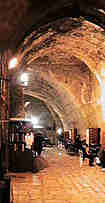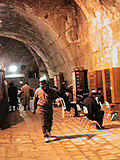
Western Wall Tunnel Tour ©

When the Second Temple was still standing, a huge bridge connected the upper city of Jerusalem to the Temple Mount. It was an easy walk across the the bridge from the upper city of Jerusalem to the Temple.
This bridge also supported an aqueduct that brought water to the Temple for use in the daily service. This was a remarkable engineering feat as the water source in Hebron many kilometers away is only slightly higher than the Temple Mount.
According to Josephus, the Jews themselves were forced to destroy this bridge during the war against the Romans in order to make it more difficult for their legions to reach the Temple. ( Read the actual account of Josephus.)
Later, in 132 C.E., during the reign of the Roman tyrant Hadrian, Jerusalem was tragically transformed into a center of pagan worship and renamed Aelia Capitolina.
At that time, the Romans rebuilt the bridge on the earlier foundations, using two parallel arches for support instead of the one original arch. The remains of the first bridge and some of the earlier stones that had been left in place since the original destruction were used in the construction of the second bridge.
Wilson's Arch, which is connected to the Western Wall, and a few others that have distinctive Herodian style, are believed to be the remains of the original bridge.
After the arches were complete, the space underneath could be used as rooms and other areas. What were these rooms like? How were they used? Who were the people that walked this ground?
Once again, you find yourself dwelling on what it must have been like, the life those people lived all those eons ago...our ancestors, fellow Jews, really...the pagan Romans...you find yourself hoping for a deeper glimpse into those times.
For a truer  sense of what it was like, let's take a slight
detour to explore one of these rooms, the Public Room, also known
as the Hasmonean Room.
sense of what it was like, let's take a slight
detour to explore one of these rooms, the Public Room, also known
as the Hasmonean Room.
| Jewish Calendar Date |
ROMAN TIMELINE |
|||
| 63 BCE: Pompey conquers Jerusalem | ||||
| 3800 | ||||
| 68 CE: Temple Destroyed. Josephus writes the Jewish War, an account of rebellion against Rome. |
||||
| 70 CE: Temple Mount laid waste; only Kotel remains. | ||||
| 130 CE: Emperor Hadrian plows Temple Mount, as
prophesied in Micha 3:12 132 CE: Hadrian forbids Shabbos, circumcision; Jewish people revolt under Bar Kochba. Jews begin rebuilding Temple. 135 CE: Bar Kochba revolt crushed; Rabbi Akiva is tortured to death. Jerusalem dubbed Aelia Capitolina. |
||||
| 3900 | ||||
| 210 CE: Mishnah edited by Rebbi Yehuda HaNasi; it includes the central principles of all Jewish law. | ||||
| 4000 | ||||
| 333 CE: Traveler from Bordeaux notes that Jews still come to Temple Mount to mourn Destruction. | ||||
| 4100 | ||||
| 353 CE: Byzantines of Constantinople, under Constantine, conquer Israel. | ||||
| 363 CE: Emperor Julian of Byzantium allows rebuilding of Temple; earthquake and fire destroy materials. | ||||
| 4200 | ||||
| 529 CE: Samaritans revolt; Jerusalem devastated. | ||||
| 4300 | ||||
| 550 CE: Emperor Justinian builds churches on Temple Mt. | ||||
| 614 CE: Persians invade Jerusalem; They allow Jewish rule. | ||||
| 628 CE: Emperor Heraclius reconquers Jerusalem; baptizes Jews by force. | ||||
| 4400 | ||||
| 638 CE: Moslems conquer Jerusalem. | ||||


